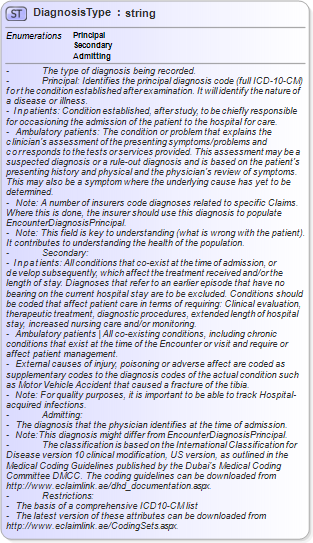<xs:simpleType name="DiagnosisType">
<xs:annotation>
<xs:documentation>
- The type of diagnosis being recorded.
- Principal: Identifies the principal diagnosis code (full ICD-10-CM) for the condition established after examination. It will identify the nature of a disease or illness.
- Inpatients: Condition established, after study, to be chiefly responsible for occasioning the admission of the patient to the hospital for care.
- Ambulatory patients: The condition or problem that explains the clinician's assessment of the presenting symptoms/problems and corresponds to the tests or services provided. This assessment may be a suspected diagnosis or a rule-out diagnosis and is based on the patient's presenting history and physical and the physician's review of symptoms. This may also be a symptom where the underlying cause has yet to be determined.
- Note: A number of insurers code diagnoses related to specific Claims. Where this is done, the insurer should use this diagnosis to populate EncounterDiagnosisPrincipal.
- Note: This field is key to understanding (what is wrong with the patient). It contributes to understanding the health of the population.
- Secondary:
- Inpatients: All conditions that co-exist at the time of admission, or develop subsequently, which affect the treatment received and/or the length of stay. Diagnoses that refer to an earlier episode that have no bearing on the current hospital stay are to be excluded. Conditions should be coded that affect patient care in terms of requiring: Clinical evaluation, therapeutic treatment, diagnostic procedures, extended length of hospital stay, increased nursing care and/or monitoring.
- Ambulatory patients | All co-existing conditions, including chronic conditions that exist at the time of the Encounter or visit and require or affect patient management.
- External causes of injury, poisoning or adverse affect are coded as supplementary codes to the diagnosis codes of the actual condition such as Motor Vehicle Accident that caused a fracture of the tibia.
- Note: For quality purposes, it is important to be able to track Hospital-acquired infections.
- Admitting:
- The diagnosis that the physician identifies at the time of admission.
- Note:This diagnosis might differ from EncounterDiagnosisPrincipal.
- The classification is based on the International Classification for Disease version 10 clinical modification, US version, as outlined in the Medical Coding Guidelines published by the Dubai's Medical Coding Committee DMCC. The coding guidelines can be downloaded from http://www.eclaimlink.ae/dhd_documentation.aspx.
- Restrictions:
- The basis of a comprehensive ICD10-CM list
- The latest version of these attributes can be downloaded from http://www.eclaimlink.ae/CodingSets.aspx.
</xs:documentation>
</xs:annotation>
<xs:restriction base="xs:string">
<xs:enumeration value="Principal" />
<xs:enumeration value="Secondary" />
<xs:enumeration value="Admitting" />
</xs:restriction>
</xs:simpleType>
|

